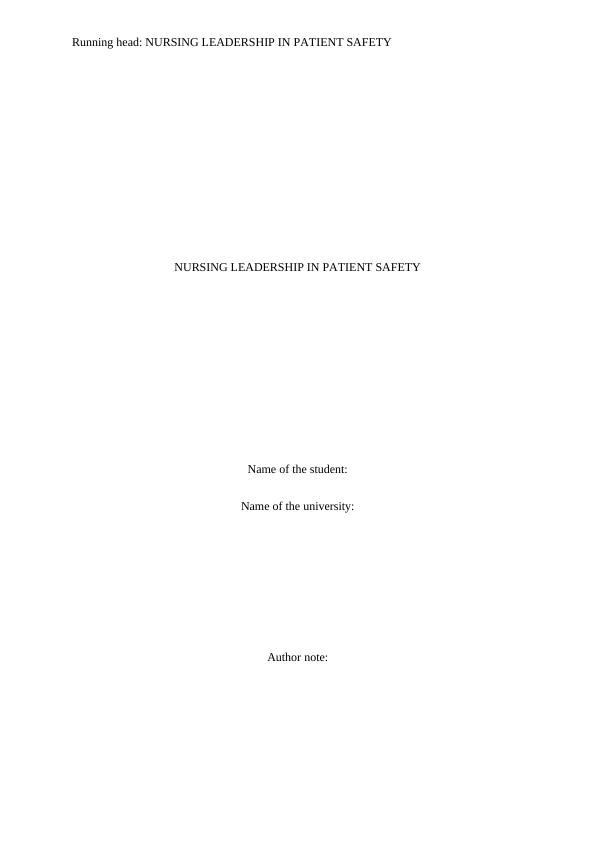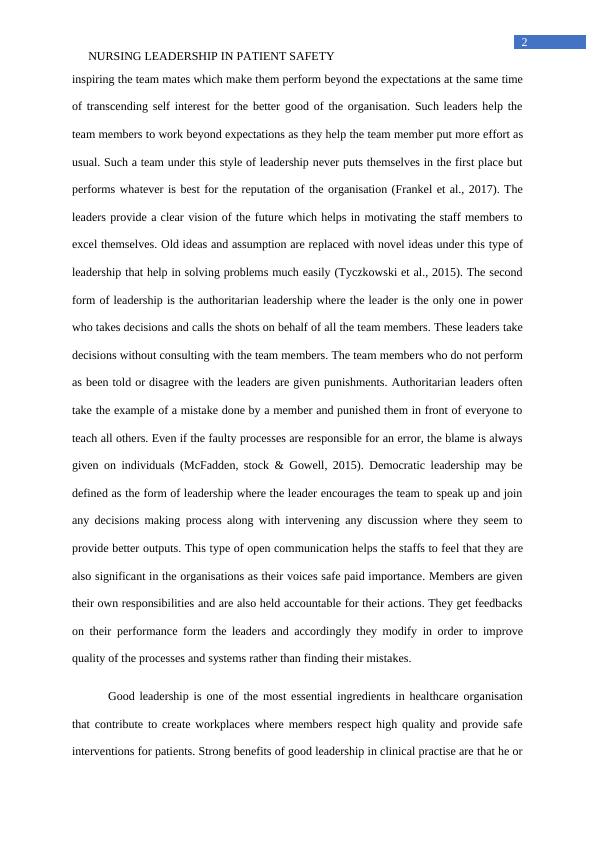Nursing Leadership in Patient Safety Healthcare
7 Pages1904 Words43 Views
Added on 2020-02-19
Nursing Leadership in Patient Safety Healthcare
Added on 2020-02-19
ShareRelated Documents
Running head: NURSING LEADERSHIP IN PATIENT SAFETYNURSING LEADERSHIP IN PATIENT SAFETYName of the student:Name of the university:Author note:

1NURSING LEADERSHIP IN PATIENT SAFETYPatient safety can be defined as the significant feature that every health care centreshould provide as the core of service to mankind. It can be described as the disciple whomainly helps in emphasizing a culture of safety in healthcare. This can be often achieved bythe steps of prevention, reduction as well as reporting and analysis of the different medicalerrors which may lead to adverse effects (Cope & Murray, 2017). Not only medical errors,the frequency as well as magnitude of any avoidable adverse events which may bethreatening to the lives of the patients should be prevented so that the patient does not haveexcessive flow of finance and also does not have to stay for long days in hospitals.Recognising any healthcare errors which might compromise quality of life for the patientwould harm the core principle of the culture of safety. Therefore it is the responsibility of thehealthcare professionals to be skilled and knowledgeable in such a way so that they canprovide the best quality care to the patients by maintaining a safe care and evidence basedplan of interventions (Lin et al., 2015). Often strong healthcare teams working in propercollaboration with each other help in the reduction of the infection rates and also help inputting checks in healthcare centres to prevent mistakes along with ensuring strong lines ofcommunication within different healthcare stakeholders like healthcare stags, patients andtheir social circles (Foronda, Budhathoki & Salani, 2014). Most healthcare centres thereforeappoint individuals with strong leadership capabilities so that the healthcare stags can getproper guidance in ensuring patients safety as the number one priority. A good leader withthe correct leadership attributes can build a team which will provide a care which is of thebest quality and achieve high level of patient satisfaction preventing dangerous complicationsfor patients, ensuring faster recovery and avoiding preventable death rate of patients.Three different types of leadership which are seen in the healthcare sectors aretransformational leadership, authoritarian leadership and democratic leadership. Intransformational leadership, the behaviour of the leaders helps in transforming as well as

2NURSING LEADERSHIP IN PATIENT SAFETYinspiring the team mates which make them perform beyond the expectations at the same timeof transcending self interest for the better good of the organisation. Such leaders help theteam members to work beyond expectations as they help the team member put more effort asusual. Such a team under this style of leadership never puts themselves in the first place butperforms whatever is best for the reputation of the organisation (Frankel et al., 2017). Theleaders provide a clear vision of the future which helps in motivating the staff members toexcel themselves. Old ideas and assumption are replaced with novel ideas under this type ofleadership that help in solving problems much easily (Tyczkowski et al., 2015). The secondform of leadership is the authoritarian leadership where the leader is the only one in powerwho takes decisions and calls the shots on behalf of all the team members. These leaders takedecisions without consulting with the team members. The team members who do not performas been told or disagree with the leaders are given punishments. Authoritarian leaders oftentake the example of a mistake done by a member and punished them in front of everyone toteach all others. Even if the faulty processes are responsible for an error, the blame is alwaysgiven on individuals (McFadden, stock & Gowell, 2015). Democratic leadership may bedefined as the form of leadership where the leader encourages the team to speak up and joinany decisions making process along with intervening any discussion where they seem toprovide better outputs. This type of open communication helps the staffs to feel that they arealso significant in the organisations as their voices safe paid importance. Members are giventheir own responsibilities and are also held accountable for their actions. They get feedbackson their performance form the leaders and accordingly they modify in order to improvequality of the processes and systems rather than finding their mistakes.Good leadership is one of the most essential ingredients in healthcare organisationthat contribute to create workplaces where members respect high quality and provide safeinterventions for patients. Strong benefits of good leadership in clinical practise are that he or

End of preview
Want to access all the pages? Upload your documents or become a member.
Related Documents
Nursing Leadership Patient Safetylg...
|8
|1698
|62
Patient Safety And Effective Leadershiplg...
|8
|1868
|536
401022 Leadership in Nursing & Midwifery | WSUlg...
|7
|1774
|161
Relationship Between Leadership Style And Patient Safetylg...
|9
|1990
|103
Leadership and Patients' Safety in Nursinglg...
|8
|2169
|78
Organizational Culture and Its Influence on Patient Safety in Healthcare Organizationslg...
|9
|1709
|446
